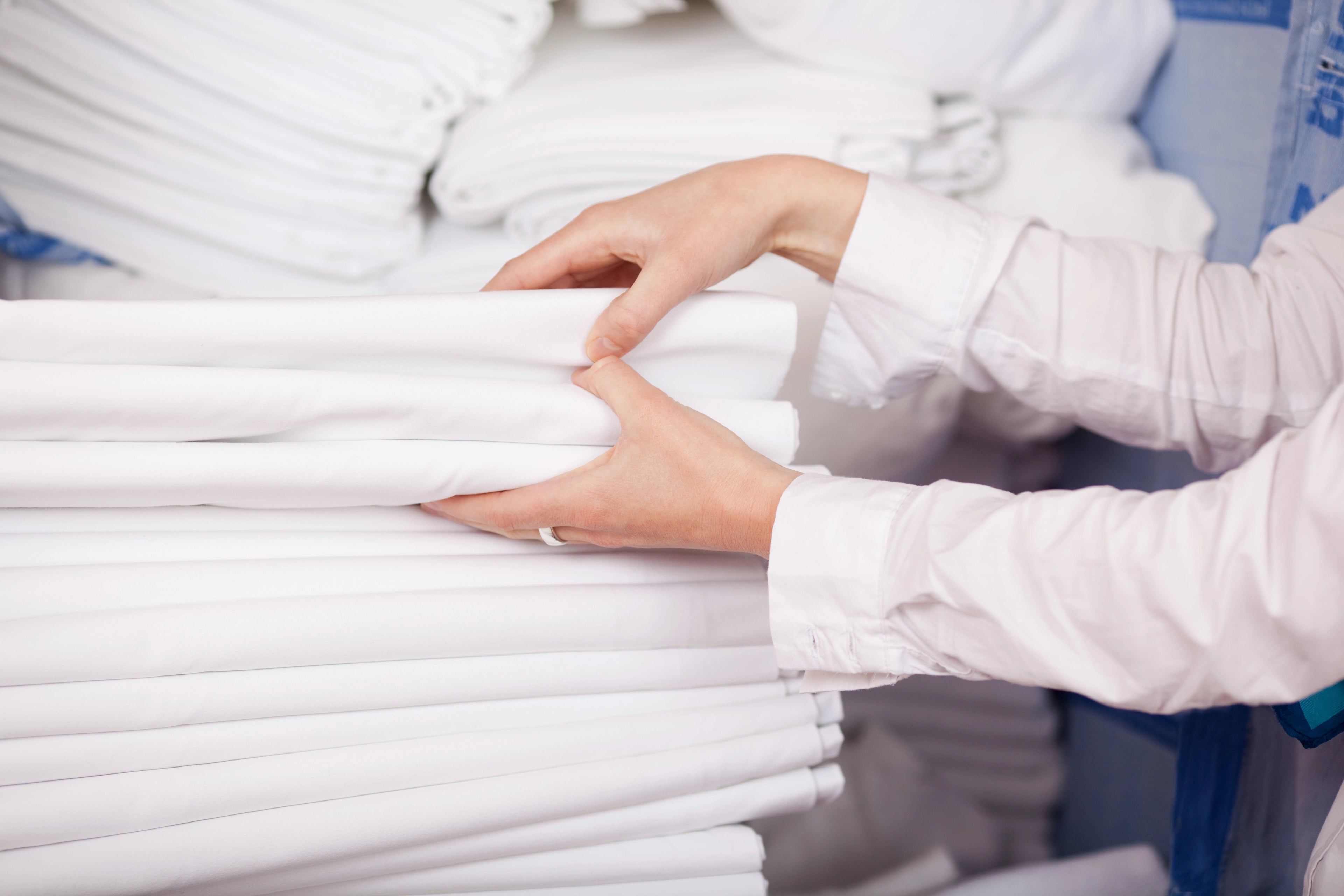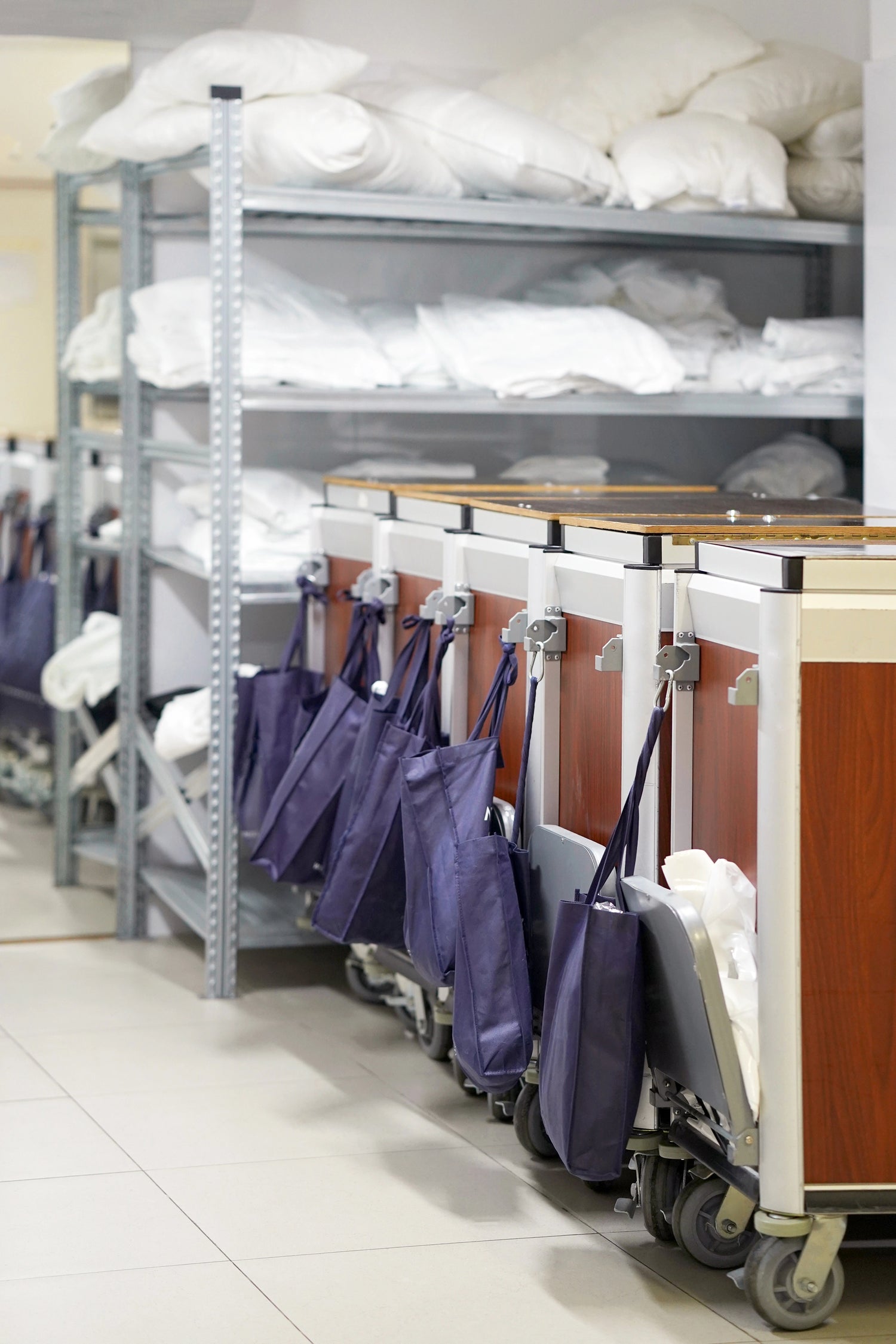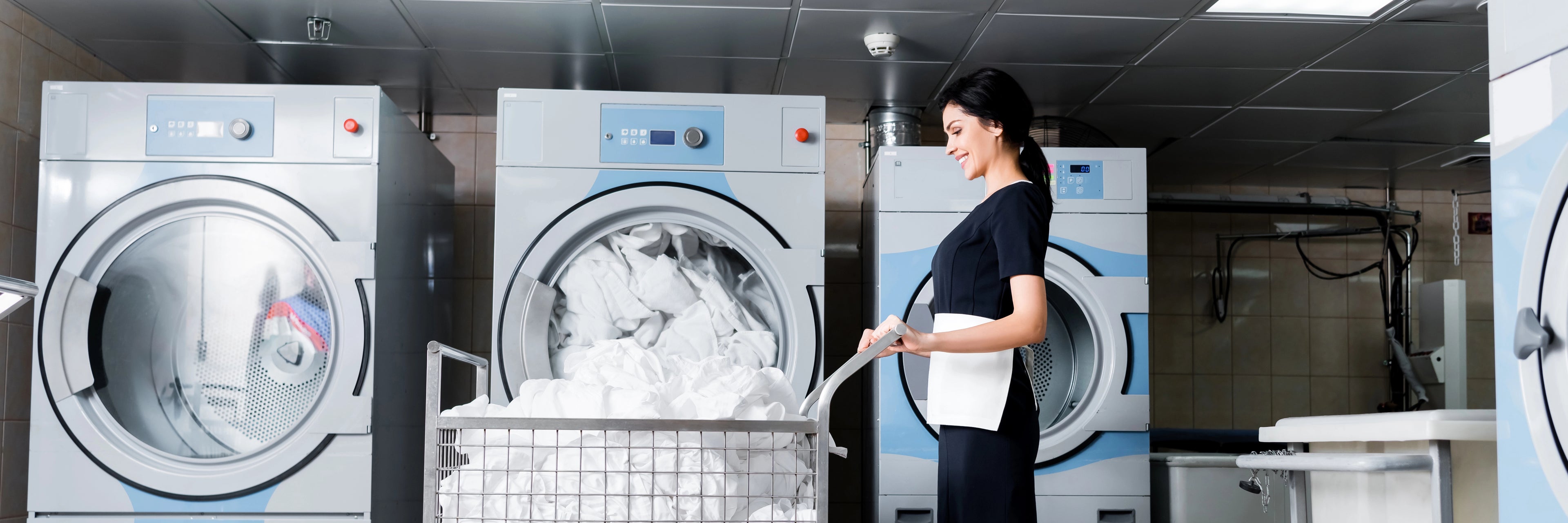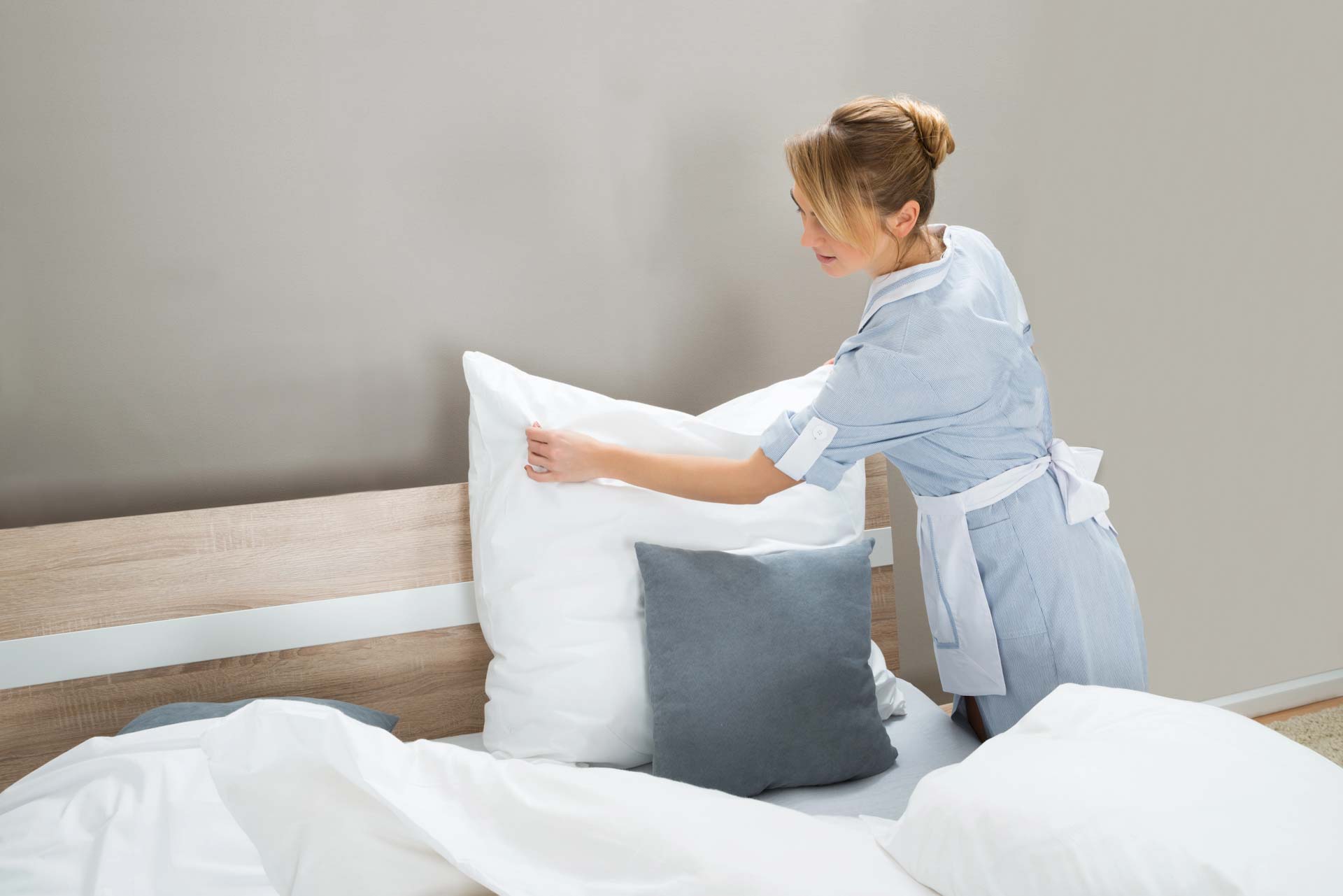
The Complete Guide to Par Levels: Hotel Linen Inventory Management Made Simple
The hospitality industry runs on precision. Every detail matters when it comes to guest satisfaction, and nothing disrupts operations quite like running out of clean linens during peak check-in hours. That's where understanding inventory management becomes critical for hotel managers, housekeeping directors, and property owners who demand operational excellence.
Whether you're managing a boutique hotel with 25 rooms or overseeing a large resort property, getting your linen inventory right isn't just about having enough towels and sheets on hand. It's about protecting your investment in quality American-made linens while ensuring your guests never experience the disappointment of subpar accommodations.
What is Par Level in Hospitality?
This inventory management concept refers to the minimum quantity of linens your property should maintain to meet daily operational needs without shortages. The term "PAR" stands for "Periodic Automatic Replenishment" - a system that calculates exactly how much inventory you need to keep your property running smoothly between deliveries, accounting for customer demand fluctuations and lead time considerations.
Think of this system as your safety net. Just as American manufacturing built its reputation on reliable supply chains and quality control, your linen inventory system needs that same dependability. A properly configured inventory level ensures you can handle everything from unexpected occupancy spikes to laundry equipment maintenance without compromising customer experience.
Where Does the Term PAR Come From?
The concept of Periodic Automatic Replenishment originated in the healthcare industry, where running out of essential supplies could have serious consequences. The hotel industry adopted this inventory management approach because hospitality business operations share that same need for reliability - guests expect fresh linens, and there's no acceptable substitute when you run short.
What is Par Stock vs Par Level?
While often used interchangeably, these terms have subtle differences. Par stock refers to the actual inventory on hand you maintain - your sheets, towels, and other textile products. Par level is the numerical target that determines how much par stock you should have on hand. Both concepts work together to create an inventory system that supports consistent customer experience.
Why Par Levels Are Critical for Hotel Operations
Proper inventory management goes beyond simple stock control. It's about protecting your investment in quality linens while maintaining the operational efficiency your guests expect. When you choose American-made products, you're investing in durability and performance - but only proper inventory management ensures you get full value from that investment.
Cotton Fabric Needs to "Rest" Between Uses
Quality cotton linens - particularly those made with traditional American craftsmanship - require recovery time between uses. Cotton fibers naturally contain about 8% water content, which gives them strength and softness. The commercial laundering process removes this moisture, temporarily weakening the fibers by up to 20%. When the water content is removed the fiber becomes weaker, more brittle, losing strength. Fabric that is dried out feels harsher and is more likely to rip, fray and pill causing more frequent replacement.
Allowing linens to rest for at least 24 hours after laundering lets the cotton reabsorb atmospheric moisture, restoring its natural strength and feel. This recovery period significantly extends product lifespan, maximizing your return on investment in premium American-made textiles. Without adequate inventory levels, you force linens back into service too quickly, accelerating wear and increasing replacement costs.
Avoiding Customer Service Failures
Insufficient inventory creates a cascade of operational problems. When hotel staff scramble to find clean linens, rooms aren't ready on time. Guests face delays during check-in or return to rooms that aren't properly serviced. One hotel discovered that their low inventory levels caused elevator bottlenecks as housekeeping staff held service elevators waiting for laundry deliveries, delaying room service and frustrating guests throughout the property.
These service failures damage your reputation and guest loyalty - problems that quality linens and proper inventory management can prevent. Maintaining adequate stock levels provides the operational buffer needed to handle unexpected situations without compromising customer experience.
Controlling Laundry Costs and Labor
Low inventory levels force more frequent washing cycles with smaller loads, increasing both labor costs and utility expenses. Your staff spends more time managing multiple small batches instead of processing efficient full loads. Energy consumption increases, along with water usage and chemical costs per item processed.
Additionally, rushing linens through the laundry cycle often requires higher heat settings to meet housekeeping schedules, which accelerates fabric deterioration. Proper inventory management allows for optimal batch sizes and gentler processing that extends linen life while reducing per-item laundering costs.nce.
What is a Normal Par Level in Hotel Laundry?
Industry standards provide clear guidance on optimal inventory management, refined through decades of hospitality business experience. These recommendations balance operational needs with cost efficiency, ensuring you maintain adequate inventory without tying up excessive capital.
The 3-Par Standard for Most Properties
Most hotels should maintain a 3-par system for linens that change with every guest stay. This means having three complete sets of every item for each room:
- One set in active use in guest rooms
- One set being laundered (dirty items being processed)
- One set ready for deployment (clean items resting and available for housekeeping)
This rotation ensures continuous availability while allowing proper recovery time for your linens. For a 100-room property, maintaining this system means having 300 complete sets of room linens in rotation.
The 3-par standard works particularly well for properties with on-site laundry facilities and predictable occupancy patterns. It provides adequate buffer stock for minor delays while avoiding the capital costs of excessive inventory.
When Hotels Need 4 or 5 Par Levels
Certain operational factors require higher inventory levels to maintain service quality and protect your linen investment, particularly when analyzing inventory usage trends and customer demand patterns.
Off-Site Laundry Considerations
Properties using external laundry services typically need 4-par or higher levels to account for transportation time and potential delivery delays. Weather, traffic, or vehicle maintenance issues can disrupt delivery schedules, and higher inventory levels provide the buffer needed to maintain operations despite extended lead times.
Off-site laundering also reduces your control over processing schedules. While you might process emergency loads on-site, external facilities work on predetermined schedules that may not align with urgent needs.
High-Traffic and Seasonal Properties
Resort properties and hotels with significant seasonal variations often require 4-5 inventory levels during peak periods. Higher occupancy rates, longer guest stays, and increased amenity usage all increase linen consumption. Seasonal properties preparing for busy periods may need even higher levels to avoid stockouts during their most critical revenue periods.
Properties with spa services, pools, fitness facilities, or extensive food service operations need additional inventory to handle the increased textile demands these amenities create.

How to Calculate Par Levels for Hotel Linens
Accurate calculations ensure you maintain adequate inventory without over-investing in excess stock. The process combines historical usage data with operational factors specific to your property, considering inventory turnover rate and customer demand patterns.
The Basic Par Level Formula
The hospitality business uses this fundamental calculation:
Par Level = Number of Sheets and Towels need to properly stock 1 guest room X number of guest rooms in a property
Consider the laundry schedule and the amount needed as safety stock to determine the level of stock needed on the shelf. Average in the industry is a par level of 3.
This formula accounts for your typical consumption patterns while building in protection against unexpected demand spikes or delivery delays, factoring in lead time considerations.
Calculate Average Inventory for a Time Period
Start by tracking your actual linen usage over at least 4-6 weeks to establish reliable averages. Count items going into service, not just items being laundered, as some pieces may be removed from rotation due to stains or damage.
(Beginning Inventory + Ending Inventory) ÷ 2 = Average Inventory
This calculation smooths out fluctuations and provides a more accurate baseline for inventory planning.
Calculate Inventory Turnover Ratio
Understanding how quickly you cycle through inventory helps optimize stock levels and identify opportunities for cost savings. The inventory turnover rate indicates operational efficiency.
Inventory Turnover Ratio = Cost of Goods Sold ÷ Average Inventory
Higher turnover rates indicate efficient inventory management, while low turnover suggests you may be carrying excess stock that ties up working capital unnecessarily.
Par Level Examples
PAR level for a 100 room property assuming all rooms are single beds.
Each guest room contains the following
1 Fitted Sheet
2 Flat Sheets (triple sheeting)
4 Pillowcases
4 Pillows
1 blanket
2 washcloths
2 hand towels
3 bath towels
1 bathmat
1-PAR in this case would be the following:
100 fitted sheets
200 flat sheets
400 pillowcases
400 pillows
100 blankets
200 washcloths
200 hand towels
300 bath towels
100 bathmats
Multiply those numbers by 3 to come to your total PAR level for the property.
Different Items Need Different Par Levels
Not every textile product requires the same inventory management approach. Items replaced with each guest stay (sheets, pillowcases, bath towels) typically need standard 3-level rotation. Items used longer-term require different calculations:
- Mattress protectors and pillows: Often use 1.25-par since they're not replaced with every guest stay
- Pool and fitness towels: May need higher levels due to theft and loss rates
- Specialty linens: Items for spa services or special events may require seasonal adjustments
Understanding these differences helps optimize inventory investment while maintaining service standards.

Factors That Determine Your Par Level Requirements
Several operational and market factors influence optimal inventory levels for your specific property. Understanding these variables helps you customize industry standards to your unique situation, considering customer demand patterns and hotel industry trends.
Hotel Occupancy Rates and Seasonality
Average occupancy significantly impacts linen consumption. A property running 64% average occupancy (the current hotel industry average) needs different inventory levels than one consistently operating at 85% or higher.
Seasonal properties face particular challenges. Beach resorts may see 90%+ occupancy during summer months but drop to 30% in off-season. Mountain properties reverse this pattern. Your inventory management should adjust for these predictable fluctuations rather than maintaining peak-season stock year-round.
Consider building flexible schedules that scale with occupancy forecasts, allowing you to optimize inventory investment while ensuring adequate stock during busy periods.
Laundry Turnaround Time and Location
Processing time directly affects how much inventory you need in circulation. Properties with efficient on-site facilities can maintain lower stock levels than those dependent on external services, with lead time being a critical factor.
On-Site vs Off-Site Laundry Services
On-site laundry provides maximum control over processing schedules and quality standards. You can run emergency loads, adjust processing priorities, and respond immediately to unexpected customer demand. This flexibility allows for lower inventory levels while maintaining service quality.
Off-site services offer cost advantages for many properties but require higher stock levels to compensate for reduced flexibility. Transportation time, external facility schedules, and potential service disruptions all increase the inventory buffer needed to maintain operations.
Loss and Damage Rates
Every property experiences some linen loss through damage, staining, and theft. Historical loss rates should factor into your calculations to avoid gradual inventory depletion, forming part of your inventory usage trends analysis.
Track loss patterns by item type - bath towels typically have higher loss rates than fitted sheets, while pool towels may disappear at significantly higher rates than room linens. Build these expected losses into your safety stock calculations rather than treating them as unexpected shortfalls.
Special Events and Peak Seasons
Properties hosting conferences, weddings, or special events need additional linen inventory beyond normal guest room requirements. Similarly, holiday weekends and local events can create occupancy spikes that strain normal stock levels.
Consider maintaining seasonal schedules or event-based inventory reserves to handle predictable customer demand increases without compromising service during your most profitable periods.
Par Level Inventory Management Best Practices
Effective par level management requires systematic approaches to inventory tracking, demand forecasting, and operational planning. These practices help maximize the value of your linen investment while maintaining service excellence.
How Often to Conduct Inventory
Regular inventory counts ensure your par levels reflect actual stock levels and identify problems before they affect operations. Most properties should conduct comprehensive linen inventories monthly, with more frequent spot-checks during busy seasons.
Monthly vs Quarterly Inventory Schedules
Monthly inventories provide timely identification of loss trends, usage pattern changes, and par level adequacy. This frequency allows for proactive adjustments rather than reactive responses to stockouts.
Quarterly inventories may suffice for stable properties with predictable operations, but monthly counts better support dynamic businesses with seasonal variations or growing occupancy rates.
Expect the Unexpected - Buffer Stock Planning
Build contingency planning into your par level strategy. Equipment failures, delivery delays, weather disruptions, and unexpected occupancy surges all test inventory adequacy.
Maintain relationships with emergency linen rental services for true crisis situations, but proper par levels should handle most operational surprises without external support. The cost of slightly higher inventory levels is minimal compared to the revenue impact of service failures.
When Inventory Should Exceed Par Levels
Certain situations warrant temporarily exceeding standard par levels:
- Pre-holiday periods: Stock up before anticipated delivery disruptions
- Major renovations: Account for potential laundry facility downtime
- Special events: Build inventory for confirmed group bookings or local events
- New property openings: Higher initial par levels while operations stabilize
Plan these inventory increases strategically rather than maintaining permanently high par levels that tie up working capital unnecessarily.
Cost Savings Through Proper Par Level Management
Well-managed par levels protect your investment in quality linens while optimizing operational efficiency. The savings compound over time through reduced replacement costs, lower processing expenses, and improved guest satisfaction.
Reducing Food and Linen Spoilage
While food spoilage doesn't apply to linens, the principle of waste reduction through proper inventory management remains relevant. Excessive linen inventory can lead to storage problems, pest issues, and deterioration from prolonged storage.
More critically, inadequate par levels accelerate linen wear through rushed processing and insufficient recovery time. Investing in proper par levels extends textile lifespan, reducing replacement frequency and maximizing the value of quality American-made products.
Avoiding Emergency Orders and Rush Fees
Insufficient par levels lead to crisis purchasing at premium prices. Emergency linen orders typically cost 25-50% more than planned purchases and may require accepting lower-quality alternatives when preferred products aren't immediately available.
Create and monthly or quarterly purchasing plan to ensure you are adequately replacing your supply. Proper par levels eliminate panic buying while enabling planned purchasing strategies that leverage bulk discounts and seasonal promotions. The inventory carrying cost is usually far less than the premium paid for emergency procurement.
Protecting Your Linen Investment
Quality American-made linens represent significant capital investment that proper par level management helps protect. Adequate par levels allow for optimal care practices that extend product life and maintain performance standards throughout the useful lifespan.
Consider par level management as insurance for your linen investment - the modest additional inventory cost protects much larger investments in quality textiles and operational reliability.
How to Use Our Par Level Calculator
Maintaining the right par levels helps streamline operations, prevent shortages, and reduce headaches for you and your team. Whether you're placing a new order, conducting an inventory review, or preparing for seasonal demand, the Par Level Calculator keeps you organized and your rooms guest-ready. Check out our calculator here-
Simply enter the number of rooms or beds.
The quantity of each item needed per bed or bathroom.
Your desired par level, typically 3 for most hospitality operations.
The calculator instantly generates the total quantities you need for each item, removing the guesswork.ility.
Common Par Level Challenges and Solutions
Even well-designed par level systems face operational challenges. Understanding common problems and their solutions helps maintain effective inventory management over time.
Adjusting for Seasonal Demand Changes
Seasonal properties face the challenge of maintaining cost-effective inventory levels while ensuring adequate stock during peak periods. Rather than maintaining peak-season par levels year-round, develop seasonal schedules that adjust inventory to match predictable demand patterns.
Build relationships with suppliers who can support rapid inventory increases for peak seasons while offering storage or buyback programs for off-season reductions. Some American manufacturers offer seasonal programs designed specifically for hospitality properties with variable demand.
Managing Different Linen Types
Different textile categories require different par level approaches. Understanding these variations helps optimize inventory investment across all property needs.
Sheets vs Towels vs Specialty Items
Bath towels typically have higher loss rates than bed linens, requiring higher safety stock percentages. Pool and fitness towels may need even higher par levels due to theft and damage rates. Specialty items like spa linens may have seasonal demand patterns that differ from room linen requirements.
Analyze each category separately rather than applying uniform par levels across all textile types. This granular approach optimizes inventory investment while maintaining service levels for all guest touchpoints.
Handling Supply Chain Disruptions
Recent supply chain challenges highlight the importance of reliable supplier relationships and adequate inventory buffers. While excessive inventory ties up capital, insufficient stock creates operational risks that can severely impact guest satisfaction and revenue.
Maintain relationships with your vendor, and consider slightly higher par levels during periods of supply chain uncertainty. The cost of additional inventory is minimal compared to the revenue impact of service failures.

Frequently Asked Questions About Par Levels
Understanding common questions about par level management helps clarify best practices and avoid typical implementation mistakes.
Should Every Hotel Have the Same Par Level?
No. Par levels should reflect each property's specific operational characteristics, including occupancy patterns, laundry capabilities, delivery schedules, and guest demographics. A resort with extensive spa and fitness facilities needs different par levels than a business hotel with minimal amenities.
Use industry standards as starting points, then adjust based on your property's actual experience and operational requirements. Regular review and adjustment ensure your par levels remain optimal as conditions change.
How Often Should Par Levels Be Reviewed?
Review par levels at least quarterly, with more frequent evaluation during periods of operational change. New properties should review monthly during their first year as usage patterns stabilize and historical data accumulates.
Seasonal properties may need different par level schedules for different seasons rather than single year-round targets. Major renovations, service additions, or significant occupancy changes should trigger immediate par level review.
What's the Minimum and Maximum Par Level?
Properties with highly reliable operations might manage with 2-par levels, though 3-par provides better operational security.
Maximum practical par levels rarely exceed 5-par except in special circumstances like seasonal stockpiling or supply chain disruptions. Higher par levels tie up excessive capital while providing diminishing returns in operational security.
Focus on optimizing par levels for your specific situation rather than pursuing arbitrary minimum or maximum targets that may not reflect your operational reality.
Ready to Optimize Your Linen Inventory?
Implementing proper par levels protects your investment in quality American-made linens while ensuring consistent guest satisfaction. Take the guesswork out of inventory management with tools and expertise designed specifically for hospitality properties who demand operational excellence.
Whether you're managing a single property or overseeing multiple locations, understanding par levels is essential for profitable operations that never compromise on guest experience.
